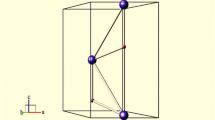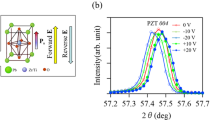Abstract
The wafer flexure technique has been developed for the rapid measurement (less than 10 minutes) of the d31 coefficient of piezoelectric thin films. The technique is based upon the controlled bending of a clamped silicon substrate coated with a thin piezoelectric film. Flexure of the wafer results in the transfer of biaxial stress from the silicon to the film, and thus the production of an electric charge. The charge produced is used in conjunction with the applied principle stresses to determine the film's transverse piezoelectric coefficient (d31). For this study, the wafer flexure technique was modified from semi-ac operation to a mechanized ac measurement (i.e. electronic pressure oscillation and lock-in charge detection). Modifications made reduce electromagnetic noise and enhance both the resolution and precision of the device. The system was used to characterize the piezoelectric properties of lead zirconate titanate 52/48 thin films between 0.6 and 2.5 μm thick synthesized using a modified sol-gel technique. The transverse piezoelectric constants (d31) of the PZT films were found to range from–60 to–90 pC/N for the 0.6 and 2.5 μm films, respectively. Aging experiments of the d31; coefficients were also conducted and results showed values to be on the order of 4 to 8% per decade.
Similar content being viewed by others
References
D.L. Polla and L. F. Francis, ldFerroelectric Thin Films in Microelectromechanical Applications,” MRS Bulletin, pp. 59–65, July, 1996.
Y. Nemirovsky, A. Nemirovsky, P. Muralt, and N. Setter, “Design of a Novel Thin-Film Piezoelectric Accelerometer,” Sensors and Actuators, vol. A56, pp. 239–249, 1996.
T. Itoh, J. Chu, I. Misumi, K. Kataoka, and T. Suga, “New Dynamic Scanning Force Microscopes Using Piezoelectric PZT Microcantilevers,” Transducers '97, Chicago, IL, 1997.
J. J. Bernstein et al., “Micromachined High Frequency Ferroelectric Sonar Transducers,” IEEE Transactions on Ultrasonics, Ferroelectrics, and Frequency Control, vol. 44, pp. 960–969, 1997.
M. O. Eatough, D. Dimos, B. A. Tuttle, and W. L. Warren, “A Study of Switching Behavior in Pb(Zr,Ti)O3 Thin Films Using X-Ray Diffraction,” Mat. Res. Soc. Symp. Proc., vol. 361, pp. 111–116, 1995.
H. D. Chen, K. R. Udayakumar, C. J. Gaskey, and L. E. Cross, “Fabrication and Electrical Properties of Lead Zirconate Titanate Thick Films,” J. Am. Ceram. Soc., Vol. 79, pp. 2189–2192, 1996.
K. R. Udayakumar et al., “Thickness-Dependent Electrical Characteristics of Lead Zirconate Titanate Thin Films,” J. Appl. Phys., Vol. 77, pp. 3981–3986, 1995.
J. F. Shepard, Jr., P. J. Moses, and S. Trolier-McKinstry, “The Wafer Flexure Technique for the Determination of the Transverse Piezoelectric Coefficient (d31) of PZT Thin Films,” submitted to Sensors and Actuators, 1997.
F. Chu, T. Su, and S. Trolier-McKinstry, “Effect of Thickness and Texture on the Ferroelectric Properties of Lead Zirconate Titanate Thin Films by Sol-Gel Processing,” The 8th US-Japan Seminar on Dielectric and Piezoelectric Ceramics, Plymouth, Mass., 1997.
W. A. Brantley, “Calculated Elastic Constants for Stress Problems Associated with Semiconductor Devices,” J. Appl. Phys., vol. 44, pp. 534–535, 1973.
J. F. Shepard, Jr., C. Fan, and S. Trolier-McKinstry, “The Effects of Film Thickness on the High and Low-Field Stress Response of Lead Zirconate Titanate Thin Films,” Ferroelectric Thin Films VI, Boston, Mass., 1997.
J. F. Shepard, Jr. and S. Trolier-McKinstry, unpublished results, 1997.
A. J. Moulson and J. M. Herbert, Electroceramics. London: Chapman and Hall, 1990.
Piezo Kinetics Inc., “Piezo Kinetics Product Specifications,”. Bellefonte, PA.
A. Kholkin et al., “Interferometrie Study of Piezoelectric Degredation in Ferroelectric Thin Films,” Microelectronic Engineering, vol. 29, pp. 261–264, 1995.
R. F. Brown, “Effect of Two-Dimensional Mechanical Stress on the Dielectric Properties of Poled Ceramic Barium Titanate and Lead Zirconate Titanate,” Can. J. Phys., vol. 39, pp. 741–753, 1961.
Acknowledgement
This work is funded under DARPA contract DABT63-95-C-0053.
Author information
Authors and Affiliations
Rights and permissions
About this article
Cite this article
Shepard, J.F., Chu, F., Moses, P.J. et al. The Influence of Film Thickness on the Magnitude and Aging Behavior of the Transverse Piezoelectric Coefficient (d31) of PZT Thin Films. MRS Online Proceedings Library 493, 415–420 (1997). https://doi.org/10.1557/PROC-493-415
Published:
Issue Date:
DOI: https://doi.org/10.1557/PROC-493-415




